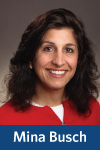 At last year’s PRIM&R Advancing Ethical Research (AER) Conference, John Wilbanks, chief Commons Officer at Sage Bionetworks, enlightened us all with his talk “Informed Consent in the Mobile Era” on the possibilities of technology utilization in research. At the 2015 AER Conference’s “Moving Targets: The Challenges of Responsible Mobile Health (mHealth) Research” session, we got to see some examples of this mobile era that have built on and expanded the use of technology. This was fascinating to see researchers’ applications come to fruition.
At last year’s PRIM&R Advancing Ethical Research (AER) Conference, John Wilbanks, chief Commons Officer at Sage Bionetworks, enlightened us all with his talk “Informed Consent in the Mobile Era” on the possibilities of technology utilization in research. At the 2015 AER Conference’s “Moving Targets: The Challenges of Responsible Mobile Health (mHealth) Research” session, we got to see some examples of this mobile era that have built on and expanded the use of technology. This was fascinating to see researchers’ applications come to fruition.
Dror Ben-Zeev, PhD, shared a smartphone application that helps with managing mental health by incorporating daily text support as well as other means of person-to-person interventions. He differentiated these from “visible” automated interventions as well as newer “invisible” interventions that are expanding into the realm of sensing (or learning) interventions. The technology provided so many interaction opportunities that would be completely unrealistic without the technology!
Stanley Shaw, MD, PhD, shared with us an application built using Apple’s Research Kit. He shared a list of benefits of a study using smartphones for trials, including having more frequent participant data, social support, and the potential for two-way exchange, among others. The framework housing the data from this application was built by Sage Bionetworks.
Dr. Shaw mentioned that the Research Kit is a software framework that makes it easier to create medical research applications. This open source technology opens up both the application creation as well as the data access.
Jeremy Block, PhD, MPP, was the final speaker in this technology trio of tremendous talks (say that three times fast!). He shared thoughts on the implication of technology in obtaining informed consent. In the scenario he shared, the process begins as potential research participants are directed to download the application (from the Apple Store). To ensure complete understanding in such technology-enabled consents, he mentioned the importance of presenting information in three modes, referring to this as the “Block Method.”
Given the growth and expansion of mobile apps just in the last year, you can be sure that mHealth is here to stay! These examples are just a glimpse of the possibilities, and they bring up another important consideration: should these smartphone applications be considered devices? In another talk at AER15, “The Internet and the IRB,” this classification was addressed as follows:
- Applications that deal with behavior change may be considered devices.
- Applications that collect and USE biomedical information would be considered devices.
I can’t wait to see what the future holds with regards to mHealth applications. Healthcare plus technology yields fascinating possibilities.
Mina Busch, program manager, research education and outreach at Cincinnati Children’s Hospital Medical Center, is a member of the PRIM&R Blog Squad for the 2015 AER Conference. The PRIM&R Blog Squad is composed of PRIM&R members who blogged here, on Ampersand, to give our readers an inside peek of what happened at the conference in Boston, MA.

One THOUGHTS ON “Fruit from the (Apple) Tree”